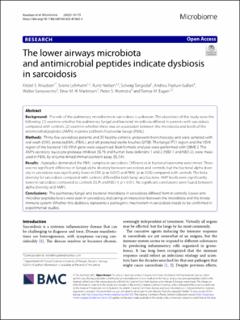| dc.contributor.author | Knudsen, Kristel Svalland | |
| dc.contributor.author | Lehmann, Sverre | |
| dc.contributor.author | Nielsen, Rune | |
| dc.contributor.author | Tangedal, Solveig | |
| dc.contributor.author | Paytuví-Gallart, Andreu | |
| dc.contributor.author | Sanseverino, Walter | |
| dc.contributor.author | Martinsen, Einar Marius Hjellestad | |
| dc.contributor.author | Hiemstra, Pieter S. | |
| dc.contributor.author | Eagan, Tomas Mikal Lind | |
| dc.date.accessioned | 2023-01-23T13:04:58Z | |
| dc.date.available | 2023-01-23T13:04:58Z | |
| dc.date.created | 2022-11-07T11:31:57Z | |
| dc.date.issued | 2022-10-19 | |
| dc.identifier.issn | 2049-2618 | |
| dc.identifier.uri | https://hdl.handle.net/11250/3045366 | |
| dc.description.abstract | Background: The role of the pulmonary microbiome in sarcoidosis is unknown. The objectives of this study were the following: (1) examine whether the pulmonary fungal and bacterial microbiota differed in patients with sarcoidosis compared with controls; (2) examine whether there was an association between the microbiota and levels of the antimicrobial peptides (AMPs) in protected bronchoalveolar lavage (PBAL).
Methods: Thirty-five sarcoidosis patients and 35 healthy controls underwent bronchoscopy and were sampled with oral wash (OW), protected BAL (PBAL), and left protected sterile brushes (LPSB). The fungal ITS1 region and the V3V4 region of the bacterial 16S rRNA gene were sequenced. Bioinformatic analyses were performed with QIIME 2. The AMPs secretory leucocyte protease inhibitor (SLPI) and human beta defensins 1 and 2 (hBD-1 and hBD-2), were measured in PBAL by enzyme-linked immunosorbent assay (ELISA).
Results: Aspergillus dominated the PBAL samples in sarcoidosis. Differences in bacterial taxonomy were minor. There was no significant difference in fungal alpha diversity between sarcoidosis and controls, but the bacterial alpha diversity in sarcoidosis was significantly lower in OW (p = 0.047) and PBAL (p = 0.03) compared with controls. The beta diversity for sarcoidosis compared with controls differed for both fungi and bacteria. AMP levels were significantly lower in sarcoidosis compared to controls (SLPI and hBD-1: p < 0.01). No significant correlations were found between alpha diversity and AMPs.
Conclusions: The pulmonary fungal and bacterial microbiota in sarcoidosis differed from in controls. Lower antimicrobial peptides levels were seen in sarcoidosis, indicating an interaction between the microbiota and the innate immune system. Whether this dysbiosis represents a pathogenic mechanism in sarcoidosis needs to be confirmed in experimental studies. | en_US |
| dc.language.iso | eng | en_US |
| dc.publisher | BMC | en_US |
| dc.rights | Navngivelse 4.0 Internasjonal | * |
| dc.rights.uri | http://creativecommons.org/licenses/by/4.0/deed.no | * |
| dc.title | The lower airways microbiota and antimicrobial peptides indicate dysbiosis in sarcoidosis | en_US |
| dc.type | Journal article | en_US |
| dc.type | Peer reviewed | en_US |
| dc.description.version | publishedVersion | en_US |
| dc.rights.holder | Copyright 2022 the authors | en_US |
| dc.source.articlenumber | 175 | en_US |
| cristin.ispublished | true | |
| cristin.fulltext | original | |
| cristin.qualitycode | 2 | |
| dc.identifier.doi | 10.1186/s40168-022-01362-4 | |
| dc.identifier.cristin | 2069892 | |
| dc.source.journal | Microbiome | en_US |
| dc.identifier.citation | Microbiome. 2022, 10, 175. | en_US |
| dc.source.volume | 10 | en_US |

